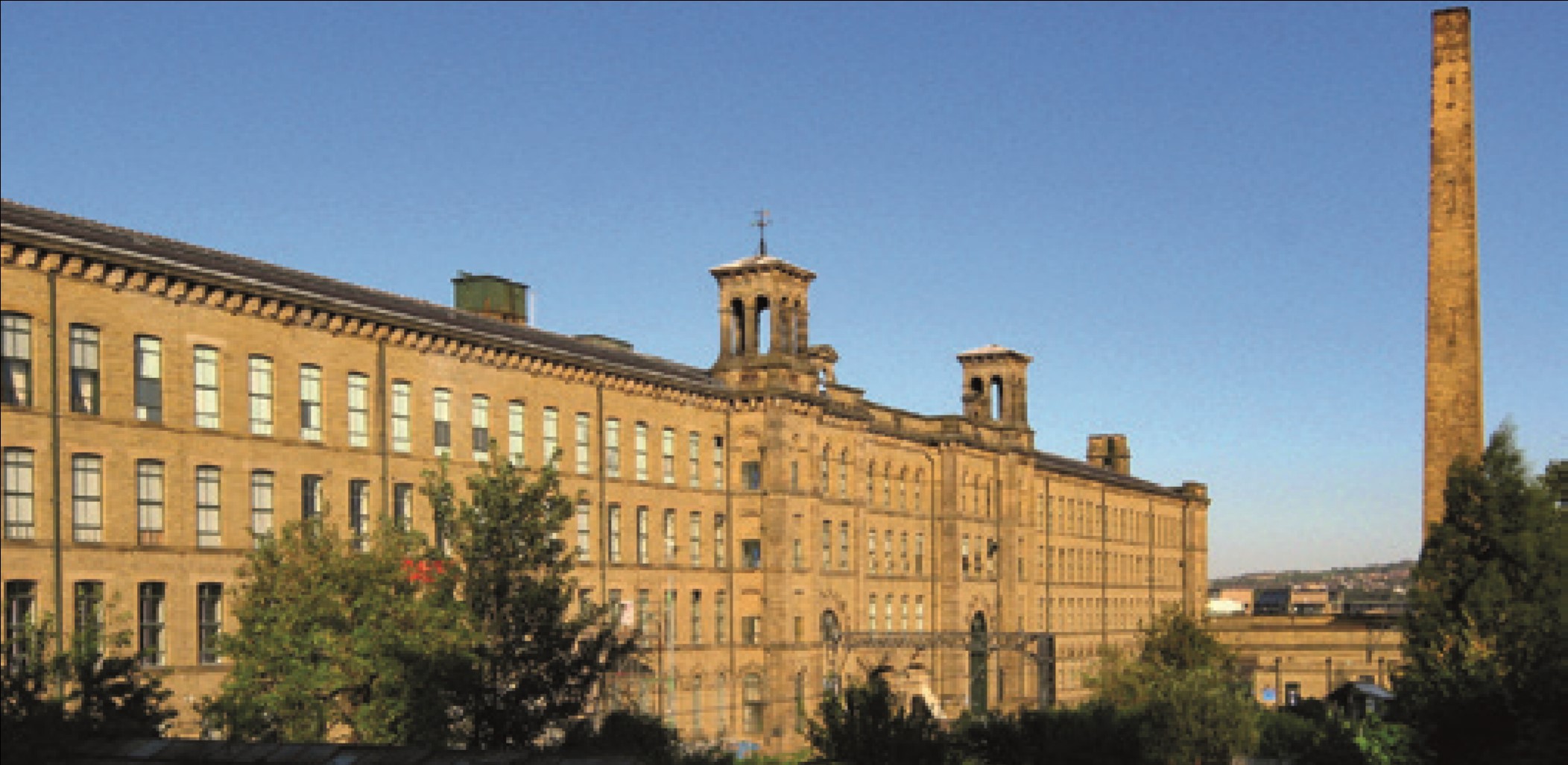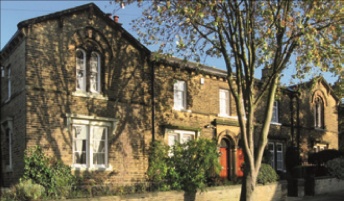Saltaire world heritage site
This article originally appeared in the IHBC Yearbook 2015. It was published by the Institute of Historic Building Conservation as: Understanding Place, Sustaining Saltaire for the Future, written by Jo Lintonbon.
[Image: Salts Mill, Saltaire (Lockwood and Mawson, 1851–53): the Grade II* listed mill, once the largest industrial building in the world, was purchased by Bradford entrepreneur Jonathan Silver in 1987 and transformed into an arts, leisure and business complex. Copyright Jo Lintonbon]
For more than half a century, academic literature has recognised that diversity of place is central to the long-term viability and sustainability of an area. For example, the journalist and activist Jane Jacobs (see recommended reading) wrote memorably about the social value of streets, highlighting the fact that a variety of activities and economic functions encouraged continued animation throughout day and evening. She promoted places that were densely inhabited with a fine architectural grain, permeable to pedestrians and made up of buildings that were diverse in terms of age and condition – urban infrastructures that were robust in accommodating change as part of a normal renewal process and the opposite of the bland monoculture of an overly staged environment.
Valuing place has also emerged more critically in conservation discourse, with a widening appreciation of the economic and social contribution made by the historic built environment, broader recognition of what constitutes heritage in terms of meaning and identity, and the impetus of conservation-led regeneration and the sensitive management of change. The contribution that local people make to place at a grassroots level has permeated this discourse, and there is now a general acceptance in planning and urban renewal literatures that dialogue and participation at a local level engender a more nuanced understanding of place and a more inclusive approach to designing the built environment.
Conservation management planning provides a framework to evaluate the significance of heritage across a range of social and cultural values and to consider its contribution to context and sense of place, physically, socially and economically. This promotes a conservation process focussed not only on understanding and managing significance but also on engaging local people in decision-making about their own neighbourhoods within a normal urban development cycle of continuity and change. This poses several challenges for the heritage professional: identifying and bringing together a representative stakeholder group which can help shape a greater understanding of place, reaching out to the wider community, and supporting an informed debate around safeguarding heritage and the opportunities for sustainable regeneration.
At the world heritage site (WHS) of Saltaire in West Yorkshire, engaging with stakeholders has been a central ambition in the first revision of its management plan since the site’s inscription on the World Heritage List in 2001. The new management plan is due to be formally adopted by Bradford Metropolitan District Council and launched in Spring 2015. It therefore seems timely to reflect on the nature of the development process of this important instrument for managing change, particularly in the context of Saltaire’s heritage status as a complex urban site.
Saltaire is a well preserved model Victorian industrial town, built for philanthropic and commercial reasons by Titus Salt to accommodate his textile workers. In the words of the UNESCO inscription, Saltaire’s ‘textile mills, public buildings, and workers’ housing are built in a harmonious style of high architectural quality and the urban plan survives intact, giving a vivid impression of the philanthropic approach to industrial management’. In its gridded layout, and the attention to detail displayed in its architecture and streetscape, the village reflects a Victorian paternalism that influenced the future development of social housing provision for industrial communities in the UK and beyond.
In addition to over 800 houses, most of the original community and public buildings and spaces remain intact and all are designated or listed, including Roberts Park, the United Reformed Church (containing Salt’s mausoleum), the mill buildings (containing retail, gallery and commercial accommodation; Bradford District Care Trust (BDCT); and residential flats), the Workers’ Institute (now Victoria Hall, a community venue), the schools and the Dining Room (now Shipley College buildings), the alms houses and the infirmary and dispensary (now converted into flats).
Despite relatively few building fabric losses, Saltaire suffered a period of decline before the mill finally closed in the 1980s and it was through several early efforts and initiatives that the village was recognised with a Europa Nostra Conservation Award in 1997 for its conservation-led regeneration.
These initiatives included:
- the establishment of Saltaire Village Society, which campaigned for the village’s protection and regeneration
- the formation of Saltaire Traders’ Association
- Jonathan Silver’s transformation of Salts Mill into an arts, leisure and business complex with PACE electronics as a major tenant
- the establishment of BDCT and Shipley College in the village
- the reopening of Saltaire’s railway station.
By the late 1990s the village was increasingly perceived as an attractive area to move to – a product of its architectural integrity and its proximity to Leeds by train – and this was reflected in its popularity in the local housing market. The conferment of world heritage status cemented the local reputation of the area and the period up to the economic crash of 2008 saw many efforts to conserve or restore the external fabric of individual houses, supported initially by local authority grants for masonry restoration and the reinstatement of original pattern doors and windows.
Originating in single private ownership, the village now contains hundreds of individual listed building owners responsible for the care and upkeep of its architectural heritage. This makes its conservation management complicated in terms of communication and coordination. Essentially, Saltaire is now a piece of town, contiguous with the wider area of Shipley, and with the ongoing public services requirements of any urban area. Its richness as a place to live, work and relax offers both opportunities and threats to the protection and conservation of its ‘outstanding universal value’ (UNESCO’s benchmark for world heritage status), bearing in mind that safeguarding for the future is often best delivered through continued economic and social use. For example, managing and increasing the popularity of Saltaire as a visitor destination, and the positive and negative implications of this in heritage terms and for local residents was an obvious issue to address.
Complementing the original Saltaire Project Group, the new WHS steering group came together in March 2013 with a remit to consider matters relevant to protecting and conserving Saltaire’s outstanding universal value and to sustaining the local economy, since this underpins the village’s conservation. Its objectives have been to identify the benefits and opportunities that world heritage status brings to the local community, to identify issues and threats facing the village, to advise BMDC on consultation and engagement with local organisations and community interest groups, and to develop a vision and management plan for the future. The steering group comprises representatives from a broad range of organisations and interest groups chosen to offer relevant knowledge and experience of life in and around the village including BMDC, English Heritage, Saltaire Village Society, Shipley College, BDCT, Canal & River Trust, Saltaire Traders and Saltaire United Reformed Church.
[Image: Bronze statue of Sir Titus Salt in Roberts Park, Saltaire (Francis Derwent Wood RA, 1903). Copyright Jo Lintonbon]
Developing an understanding of Saltaire as a place prompted early discussions among the steering group panel and a draft vision statement was agreed that framed the development of the new management plan around themes of sustainability and community. This was tested in two workshops organised to gauge local agendas, values and priorities related to the village.
The first workshop was an invitation event for identified stakeholders attended by 32 external organisations plus council officers and elected council members. As well as debating a short- and longterm vision, invitees participated in a SWOT analysis (evaluating strengths, weaknesses, opportunities and threats) around themes on protecting and conserving, interpreting, sustainable transport, economic sustainability and tourism, and management. Participants were also asked to propose ‘Big Ideas’ and to collectively identify priorities. The second event was a world heritage forum for local residents, run in a similar way.
[Image: Housing on Albert Road to the west of the village. Copyright Jo Lintonbon]
Each event generated different priorities, generally reflecting the differences between those who visit and travel to Saltaire, and those who live in the village. The stakeholder event showed strong interest in the following areas:
- an arts, cultural and/or visitors’ centre
- an ‘open house’ to recreate Victorian working life
- parking, pedestrian and alternative transport solutions
- a distinct Saltaire ‘brand’.
Residents were more concerned with building fabric, townscape and environmental issues, including empty properties at risk, the condition of alleyways at the rear of properties, enforcement issues on listed property and parking. At the same time data was collected via a visitors’ survey, employees at Bradford District Care Trust were canvassed about Saltaire as a place to work, and local schoolchildren took part in creative arts projects focussed on Saltaire. The issues raised were assessed by the Saltaire WHS officer, Helen Thornton, for inclusion in the draft management plan. The management plan was then developed with the steering group and put out to a nineweek public consultation via an online and paper-based survey, direct mail to stakeholders, a public exhibition in the village and a stall at Saltaire Festival. Feedback to the plan was reviewed by the steering group and revisions incorporated, creating a document with six key objectives and 63 action points on short-term, medium-term, aspirational and ongoing timescales.
The process of establishing conservation and regeneration needs and engaging across the community has been both robust and comprehensive, with contributions made by groups and individuals encompassing diverse local community and economic interests. The extent to which these various social and economic uses have been recognised and understood, in what is ultimately a consensus plan, underpins the longterm safeguarding of Saltaire and its success in maintaining regeneration momentum and protecting its outstanding universal value.
Establishing fair representation and encouraging individuals to contribute has not been without difficulty, evidenced in the limited public response to the consultation process. Key organisations have chosen not to be involved in drafting the plan (for example, Salts Mill which contributes so positively to the ongoing vitality of the village). Likewise, local residents are much more likely to engage in local environmental issues reactively. This is clear in a number of recent development proposals which have exercised sections of the community, including plans to reuse the historic weir for power generation, a new college building within the conservation area, and removal of existing trees which were not part of the original village design as part of streetscape restoration work.
There will always be some conflicts over plans that split local opinion and these necessitate careful management by the local planning authority, particularly when balancing heritage with sustainability. Local residents are the majority stakeholders in the village and their quality of life is central to its success. Ultimately the value that they place on its heritage will sustain it as a place for the future, and local initiatives and activities suggest a rude grassroots health. They include:
- Totally Locally Saltaire, an initiative which promotes local shops and businesses
- A Taste of Saltaire, a local food growing project
- The Saltaire Review, a new community magazine
- Saltaire Festival, an annual festival founded in 2003
- Saltaire Inspired, an organisation which promotes arts and community events including makers’ fairs at Victoria Hall
- Saltaire Arts Festival, for which residents open up their homes to display and sell the work of local artists
- Saltaire Living Advent Calendar, during which windows in the village are decorated and lit for Christmas
- at the time of writing a film production company is also on location in Salts Mill, shooting a film projected for release in 2015.
These events have a far wider reach than the boundaries of the village and are a bellwether for the validity of the vision for Saltaire as ‘a welcoming and inclusive place with a vibrant community, which takes inspiration from its past, whilst planning for a sustainable future and striking an effective and creative balance between a place to live, invest in, work, learn and visit’ (Saltaire World Heritage Site Management Plan Consultation 2014).
Recommended Reading: J Jacobs, The Death and Life of Great American Cities, Random House, New York, 1961
Jo Lintonbon PhD is an architect and historian. She directs the MA in conservation and regeneration at Sheffield School of Architecture, University of Sheffield. She is the ICOMOS-UK representative on the Saltaire World Heritage Site steering group.
--Institute of Historic Building Conservation
Related articles on Designing Buildings Wiki
IHBC NewsBlog
Old Sarum fire in listed (& disputed) WW1 Hangar - Wiltshire Council has sought legal advice after fire engulfed a listed First World War hangar that was embroiled in a lengthy planning dispute.
UK Antarctic Heritage Trust launches ‘Virtual Visit’ website area
The Trust calls on people to 'Immerse yourself in our heritage – Making Antarctica Accessible'
Southend Council pledge to force Kursaal owners to maintain building
The Council has pledged to use ‘every tool in the toolbox’ if urgent repairs are not carried out.
HE’s Research Magazine publishes a major study of the heritage of England’s suburbs
The article traces the long evolution of an internal programme to research 200 years of suburban growth
IHBC Context 183 Wellbeing and Heritage published
The issue explores issues at the intersection of heritage and wellbeing.
SAVE celebrates 50 years of campaigning 1975-2025
SAVE Britain’s Heritage has announced events across the country to celebrate bringing new life to remarkable buildings.
IHBC Annual School 2025 - Shrewsbury 12-14 June
Themed Heritage in Context – Value: Plan: Change, join in-person or online.
200th Anniversary Celebration of the Modern Railway Planned
The Stockton & Darlington Railway opened on September 27, 1825.
Competence Framework Launched for Sustainability in the Built Environment
The Construction Industry Council (CIC) and the Edge have jointly published the framework.
Historic England Launches Wellbeing Strategy for Heritage
Whether through visiting, volunteering, learning or creative practice, engaging with heritage can strengthen confidence, resilience, hope and social connections.

















